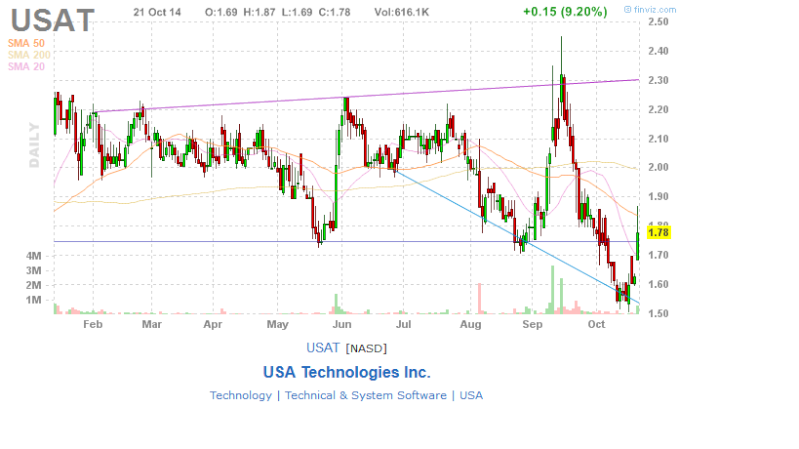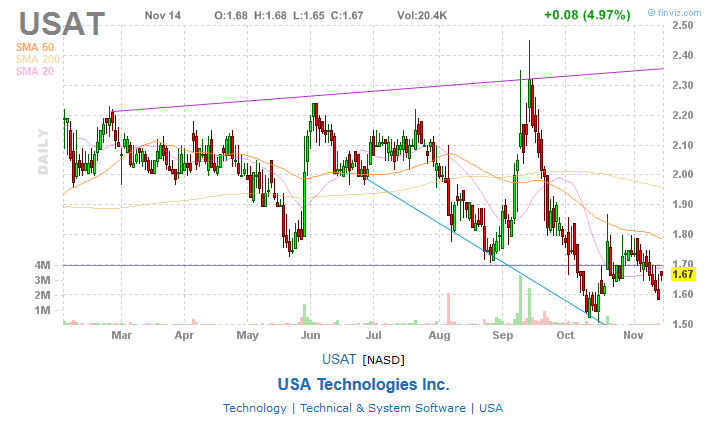Análise de Paulo Santos no seeking alpha : VER AQUI .
USA Technologies: Good Growth But There Are Doubts
Oct. 20, 2014 8:58 AM ET | 7 comments | About: USA Technologies, Inc. (USAT), Includes: KO Subscribers to SA PRO had an early look at this article. Learn more about PRO »
Disclosure: The author has no positions in any stocks mentioned, and no plans to initiate any positions within the next 72 hours. (More...)
Summary
USA Technologies presents a very interesting growth story.
USA Technologies is the beneficiary of many different trends towards cashless payments.
However, I also identified several possible red flags which balance out the apparent positives.
When I started my due diligence process on USA Technologies (NASDAQ:USAT), what I saw was a very appealing story with ongoing growth and a very tiny market capitalization. These are usually ingredients for substantial upside. The situation, however, would turn out to be quite a bit more complex from an investment standpoint.
The business
Most of USAT's business comes from selling hardware and software/services which enable cashless/electronic transactions in unattended Points of Sale (POS). This means enabling many small ticket vending machines to accept credit cards, debit cards, prepaid cards, benefits cards or even electronic NFC payments such as Apple Pay.
Furthermore, USAT also sells M2M solutions based on its cashless transaction products and services. These solutions can enable to operationally optimize the vending machines, leading to cost reductions, better inventory control and a more thorough knowledge of the consumer.
There is a clear trend towards cashless transactions. There's also a clear trend towards the welfarization of the economy (leading to more usage of EBT cards). And there should be a clear trend towards NFC payments as well. Finally, there is also a clear trend towards M2M. As it stands, USAT is positioned to be the prime beneficiary of many highly-visible trends. Thus, if USAT executes well, the stock market is likely to take notice.
These trends lead to growth
Not surprisingly, the above-mentioned trends made it rather easy for USAT to recently show sustained growth. The growth has been evident in revenues, new connections to its ePort network and new customers. At this point, this sustained growth is the main attractive in USAT's business, along with the story regarding all the trends it's exposed to.
The growth is well represented in the following slide from the most recent company presentation:
(click to enlarge)
And not only is the company growing, but the nature of its revenues is also attractive - these are recurring service revenues, for the most part, as shown below:
(click to enlarge)
Furthermore, these revenues are available at an interesting gross margin, so if the growth continues it's likely that it will help a trend towards profitability. Gross margins in the most recent quarter were 32.7% of revenues - these were down from 37% in the same quarter the year before, though.
Still, at this point what we have is an interesting story, with good and stable growth, a lot of recurring revenues and decent margins at the gross margin level. And while earnings for FY2014 were basically zero, the company claims that part of this was due to grace periods on many of its new contracts. These grace periods, as they expire, are supposed to lead to an additional $5.5 million in revenues during FY2015, which is significant in a company that did $42.3 million in revenues during FY2014.
Indeed, the company is guiding towards revenue growth of around 22.9% for FY2015, so growth is expected to continue at a high level.
The negatives and risks
Unfortunately, this story isn't as easy as I expected it to be. Even if scale might be the reason that net profits are not yet gushing, there are many other issues which need our attention. I'll enumerate them here, as anyone contemplating investing in this particular stock needs to be aware of them.
The business eats cash upfront
USAT's business eats cash upfront. FCF is negative as even though the company produced $7.1 million in operating cash flow during FY2014, it then had capex of $11.0 million to contend with.
This is so structurally (for now, at least). It stems from the fact that most (60%) of its new gross connections come from the company's "JumpStart" program, where the customer faces no upfront cost for the company's hardware products, and instead rents those same products through fees included in its service agreement with USAT. This creates a large (and recurring) capex outlay for USAT, which ends up owning most of the ePort devices in the field.
The company claims it's heading towards free cash flow generation, but that's just including sale and leaseback transactions of its ePort devices. This is more a kind of financing cash flow. It is likely that on an operating basis, the company will still be free cash flow negative for years.
The company has long been a dog
This is self-explanatory. A look at a long term chart tells the story (Source: Yahoo Finance)
(click to enlarge)
This raises the question of whether USAT is an intrinsic dog. But we could also give it the benefit of the doubt - the ePort business seems like a real business, with just a few "hairs".
One such hair - The Coca-Cola Company (NYSE:KO)
USAT has recently been sued by The Coca-Cola Company. At the core of the dispute is the allegation by Coca-Cola that USAT kept on operating its card-reading devices after Coca-Cola and USAT parted ways two years ago. Coca-Cola is claiming $1 million in damages.
Coca-Cola operates hundreds of thousands vending machines, and this feud highlights a possible problem - for very large vending machine operators, it makes sense to have their own ability to collect cashless payments, as the fees USAT charges can be relevant (as much as 5.95% of sales).
This problem with Coca-Cola can thus be replicated elsewhere. Or it might happen that the vending machine makers, themselves, build the feature into their vending machines right at the factory. Indeed, at this point USAT lists Coca-Cola as a major competitor. It would seem that Coca-Cola went the way of building the capacity itself.
Business is always exposed to low-margin competition
The Coca-Cola episode, along with the possibility of the cashless payments being built into vending machines at the factory, creates the likelihood that the space will forever be exposed to low margins.
We can hear talk about how Square is financially challenged. Or we hear how Amazon.com wants to enter the same space (though not in unattended vending machines, mind you). This gives me the fear that low margins might be a feature of this market.
Risky financial profile
Another risk I identified was that due to the cash-burning nature of the business at this point, USAT actually displays a risky financial profile. Namely, its current ratio now rests below 1, with current assets of $14.6 million and current liabilities of $15.2 million.
It's no surprise that USAT is engaging in sale and leaseback transactions for its ePort portfolio. It's the one easy way it has to generate cash to compensate the current burn rate. The need to do this won't change in the near-future, either, as the cash-burning nature of the business is likely to remain as long as growth remains strong.
Possible low-margin push
Then there's something which worried me somewhat. USAT's gross additions reaccelerated in Q3/Q4 FY2014 after flagging a couple of quarters before. The slowing growth seems to have led USAT to be more promotional in its selling activities. This in turn led to lower gross margins and the existence of "grace periods" for some new customers.
It's hard to tell whether margins will be regained in the future, or if this promotional push will have to remain in force.
Mismatch between depreciation and lease terms
Another potential worry which I uncovered was how the ePort devices were typically contracted for 36 months (though cancellable), whereas they were being depreciated over 5 years. This means that near-term depreciation might be underestimated and thus near-term earnings might be overestimated (even though they're zero).
This worry loses meaning if the company can easily continue to operate its ePort devices in the field after the 36 months expire. Indeed, if these devices were to outlast the 5 year depreciation period, then we'd see a significant upward impact in reported profitability.
Customer concentration risk
On top of what I said, there's also significant risk in that 23% of USAT's FY2014 revenues came from a single customer, the Compass Group. While this reliance of Compass has slowly been reduced, it's still very significant.
Valuation
Presently, USAT trades for 11.4x EV/EBITDA (this includes $16.7 million in preferred stock). This is not incredibly cheap on an absolute basis, especially taking into account the present cash-burning nature of the business.
On the other hand tech companies with similarly interesting growth stories and/or subscription revenues have sustained much higher EV/EBITDA ratios in the present market.
Conclusion
I am left rather undecided when it comes to USAT. The story is very alluring, even if earnings are not there yet and the business consumes cash upfront. Ultimately, the success of this business lies on whether USAT is establishing a fleet of payment devices which will then remain on the field collecting fees for many years to come.
I ultimately think that economies of scale can push USAT into decent profitability. Indeed, the company has a long-term (3-4 years out) objective of attaining 13%-17% operating margin (and this on $100 million in revenues). What worries me is that even if it attains this lofty objective 3-4 years from now, the company would already be trading at 5x EV/EBIT today even after the stock dropped so much. So being positive on USAT today requires one to believe that the company will greatly exceed even its own guidance.
All in all, I'll remain neutral, but with an eye towards perhaps one day revisiting the stock.
Editor's Note: This article covers one or more stocks trading at less than $1 per share and/or with less than a $100 million market cap. Please be aware of the risks associated with these stocks.





 Início
Início










